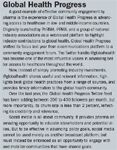Can Social Media Give Big Pharma Back its Reputation?
Industry's ability to master the external environment depends on making the 140-character shorthand of the Twitter generation its own.
Big Pharma's approach to social media is a work in progress, with the will to engage hampered by the impact of regulation and reputation. The medium wants companies to talk, but regulators and their legal interpreters press heavy on the mute button, while patients and the public wonder whether anything credible can come from listening in. I recently took a trip on a packed Acela train from Newark, NJ to Washington DC with some bright young things from a digital agency working for the industry. They spent the journey lamenting the days when they could set up patient front groups and slip off-label claims onto "sponsored" sites. Anything involving real engagement with real people was illegal and, at any rate, undesirable. Specifically, I was told that a single New York Times reporter, Duff Wilson, is assigned to cover tobacco and pharmaceuticals. Their conclusion: "That's all you need to know about how Big Pharma is viewed on social media."

Getty images: Russell Tate
The lesson I draw from this is that pharma companies looking to influence policy and practice through social media must avoid putting the emphasis on precedents from their well-funded advertising and corporate communications campaigns. Instead, they should look to examples of engagement around alliance development and patient outreach programs, four of which we profile in sidebars to this story.

Those table-mates on the Acela seem to reflect a lot of the thinking from Big Pharma on digital communication. A review of links to brand-sponsored patient communities reveals that many of them no longer work. Those that do often resemble the digital equivalent of a declining prairie-state town, with people and props frozen in time. The blame seems deflected away from the companies themselves: a recent survey by the consultancy Cutting Edge found that industry is dissatisfied with its digital agencies. Not one of the 34 respondents thought that their experience with outsourced digital marketing had been very good; a third thought it was poor.

Global Health Progress
But there must be some decent people in the field. There are a few good examples of product-led sites, with some clever examples of patient involvement. Tiny UCB, for example, has created some innovative design tools around a yet-to-be-launched medicine for Crohn's disease. The glaring omission here is anything about the big questions in health—the ones that will decide whether you and I have a job in the industry in 10 years' time. No one in Big Pharma is using social media to shape the decisions that policymakers make on health, despite growing evidence that the Twittersphere is molding opinion and thus calling the shots.
To be taken seriously on policy, companies need to use the social media networks to position themselves as helpful participants in the debate. Through their online engagement they need to identify and advance shared goals with allies, even if those allies don't necessarily agree with the company's approach.
What if industry behaved like citizens?
The litany of excuses for pharma's invisibility has been reinforced by recent FDA decisions on the use of social media. But even without the dead hand of the FDA, some observers suggest that pharma wants to play the role of a second-grade consumer marketer, not that of a thoughtful citizen. In many ways, it's a lost opportunity; because we feel passionate about health, we talk about it. A recent Price Waterhouse Coopers study shows that healthcare community sites generate 24 times the social media activity of corporate healthcare sites. According to the study, "one-third of consumers now use social media sites such as Facebook, Twitter, YouTube, and online forums for health-related matters, including seeking medical information, tracking and sharing symptoms, and broadcasting how they feel about doctors, drugs, treatments, medical devices, and health plans."

Pharma companies need to start by acting as just a fellow citizen. That means listening to the conversation and looking for opportunities to contribute. That contribution can be as simple as adding relevant and useful information, or identifying other credible sources and amplifying thoughtful conversation, without trying to drive it.
Policy debates on Medicaid and healthcare reform are fought out in 30-second TV spots and through frantic grassroots lobbying. Bigger issues such as obesity or ageing are consigned to public television and funded by dull corporate grants. However, policy discussions can no longer be confined to low-rated TV stations and smoke-filled backrooms. This view of how policy is conducted is as wrong as the approach of one former Big Pharma company, American Home Products (AHP), which, back in the 1980s, believed in the virtue of anonymity and ignored the press until it was confronted on its CEO's home turf. I had the misfortune to work as a consultant to AHP when a British investigative journalist repeatedly requested interviews about alleged addiction to its drug Ativan; management ignored the questions until the journalist followed CEO Bernard Canavan on to the golf course on a Sunday morning in search of that exclusive moment. Instead, Canavan hit the reporter over the head with a golf club. On camera.

PassItOn
Pharma's fear of intimacy
What Canavan did seems absurd to us today because we know what happens to corporations that try to live without the press. Corporations that try to live without social media will seem even more anachronistic in 20 years' time. Just ask President Obama. Obama's 2012 campaign has sunk a fortune into the real power of social media. Not the neolithic display advertising that Big Pharma supports, and certainly not those actors reading bad scripts while pretending to be patients. How do you get voters—many of them disillusioned and demoralized—to donate and vote and to persuade their friends to do the same? Hundreds of young volunteers in the Chicago HQ are working on Operation Vote, a project that uses the intimacy of Facebook and Twitter to relate to voters as individuals: its targets include the transgendered—even chefs in restaurant kitchens. If you are a chef with a sexual identity crisis, you will be amazed at how well the President appears to understand the issues of cooking while wearing size 14 heels. Marilyn Katz of the Obama campaign says, "You have millions of young voters who don't get their news from TV but from social media and friends online. You have to penetrate each one of those venues. In the same way, older voters may hear something on TV but are much more likely to vote depending on what their neighbors are doing. It's those intimate type of conversations, among networks of friends, that get you out of your house and into the voting booth."

If people can be persuaded to get excited about voting again for President Obama, can they be persuaded to care about how healthcare dollars are divided up and whether there are incentives for innovation? Definitely. Unfortunately, however, it tends to be the other side doing the persuading. If you can bring yourself to "like" Médecins sans Frontières (MSF) on Facebook, you can join their 500,000 FB friends. You could also join the 1,500 people who like their YouTube video protesting the Novartis stand on patents. Or you could sign just up for their Twitter hashtag, #stopnovartis. If you can't hit the button to friend MSF, no problem: you can look at the 12,000 FB'ers who like Avaaz's campaign to "stop pharma killing thousands to make millions."

Robin Hood Tax
There are, of course, risks in this kind of relationship building: friends sometimes talk back. Amongst Merck's followers on Facebook is an obsessive poster named Michelle Petersen (from Petersburg, IL) who puts up comments such as this: "Merck can't wait to get a hold of those babies and force poison into them." Overall she ends up looking crazy while Merck sounds pretty reasonable and trustworthy. It's a pity that only 3,000 Facebook fans get to see it—over 40,000 people still work for Merck in the United States alone. Assume that only 50 percent of them are on Facebook; assume that each has below the Facebook average, with about 100 friends who they don't know from work. That would amount to a network of 2.5 million people.
Given that both hard-pressed industry employees and social media are growing in credibility, there is a clear opportunity to bring the two together to create a vast new network of "employee ambassadors"—that is, people who talk about the company online in a quasi-official capacity. The fall in CEO credibility makes it more important than ever to prepare employees to advocate on the organization's behalf. A recent Edelman study shows CEO credibility sinking 12 percent in the past year, while the same study shows the credibility of "regular employees" and "a person like yourself" increasing 16 percent and 22 percent respectively. These numbers may reflect the growing trend of distrust for corporate messaging and slick PR.

Oddly, Pfizer, the current owner of the AHP inheritance, may be doing this better than others. The company has over 50,000 likes on Facebook, although only 600 people are talking about their online presence despite an admirably clear policy on the posts they remove from their Facebook page and why. The number of followers is driven in part by Pfizer's innovative blog, "Think Science Now," which gives its scientists and their guests a forum to pose big thoughts. As the company says, "we remain the only large pharmaceutical company empowering our colleagues, those closest to the science, to use social media to talk about the innovative work they are doing." Maybe it is also due to the frequent updates from the employees who volunteer for short-term assignments with international development agencies. But you will search in vain for anything about the views of the company or its people on differential pricing, the reliance of many US states on charity to treat sick people with HIV, or on any other big policy issue.

Swabhimaan India
Compare this with the American Association of Retired Persons (AARP), which has about 220,000 likes on Facebook and about 18,000 people talking about its policy agenda. These are serious discussions, such as "You've Earned a Say," a national conversation to ensure that Americans have a voice in the future of Medicare and Social Security, led by the question, "If you had a moment with the President or a member of Congress, what would you tell them about Medicare and Social Security?" But the conversation is broad and attuned to life in the street, as evidenced by a recent stream around the fact bite that 760,000 Americans over age 65 had undergone elective cosmetic surgery in 2011. It's that mix of gossip, news, and serious debate that gets the adrenalin going around this 18,000-strong community. And wins the attention of the policy cosmetologists on Capitol Hill.
Are politicians listening?
Still, many observers are skeptical about whether any of this actually affects public policy. The four case studies in the sidebars provide real examples of what happens when policymakers (well, maybe their interns) see a subject catching fire on Twitter or even just turning up on Google +.
How an obscure, complex issue can be fodder for a spiraling popular culture obsession is best exemplified by the viral video, Kony 2012, which has notched more than 100 million views on YouTube. The video is about a Ugandan rebel warlord, Joseph Kony, and his enslavement of children as soldiers. The grassroots campaign it spawned has the backing of celebrities such as George Clooney and Oprah Winfrey and politicians including George W. Bush and John Kerry. As Senator Lindsey Graham of South Carolina said, "When you see 100 million Americans looking at something, it will get our attention. This YouTube sensation will help Congress be more aggressive and will do more to lead to Kony's demise than all other actions combined." US Special Forces are now helping the Ugandan Army to track down Kony.
However, many Ugandans dislike the video and accompanying campaign. Astutely, they think that the video is building Kony's mystique and trivializing the region's many problems. The slick campaign got a lot of views and attention but also raised questions about the video sponsor, an NGO called Invisible Children, and its funding and motives—questions that the group was not prepared to answer. The media backlash in the United States and Canada was swift and severe.
Contrast the Kony 2012 campaign with the example of Global Health Progress (see sidebar). While Global Health Progress certainly could afford to create a slick video like Kony 2012, they instead chose to subtly engage with allies and with the community in an effective manner, to help advance healthcare in low- and middle-income countries.
Pharma has a choice. Does it apply the slick lessons of the anti-Kony campaign to domestic and global health issues? Does it invest in big ticket, simplistic message campaigns to advance its cause, or engage carefully behind the scenes with allies like Global Health Progress? Or does it look back to the days of AHP's punch-drunk encounter with the media on the golf course? Whatever the path, precedent suggests its profile has nowhere to go but up.



















Is Artificial Intelligence a ‘Product’? Products Liability Implications for AI-Based Products
April 10th 2025As the physical products we use evolve to become increasingly complex, traditional products liability frameworks may not always fit to provide remedies for harm that can result from using novel product types.
Is Artificial Intelligence a ‘Product’? Products Liability Implications for AI-Based Products
April 10th 2025As the physical products we use evolve to become increasingly complex, traditional products liability frameworks may not always fit to provide remedies for harm that can result from using novel product types.
2 Commerce Drive
Cranbury, NJ 08512
All rights reserved.

.png&w=3840&q=75)

.png&w=3840&q=75)



.png&w=3840&q=75)



.png&w=3840&q=75)